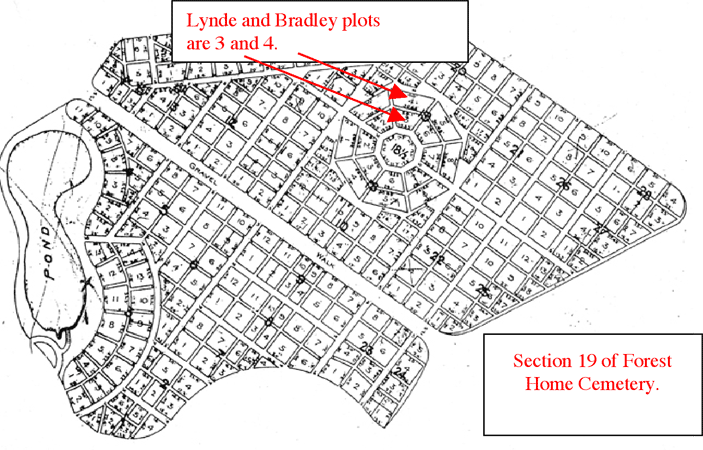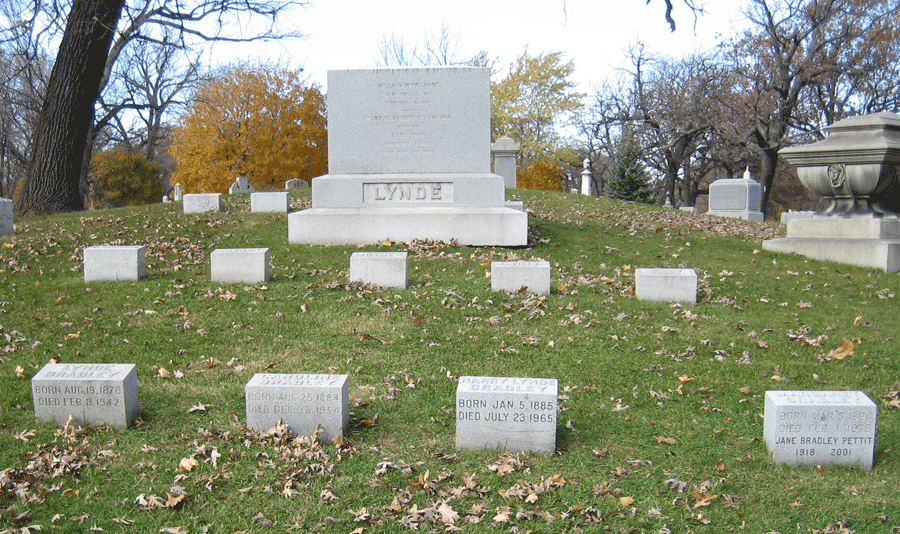A representative of the International Brotherhood of Electrical Workers Museum in Washington, DC, Michael D. Nugent, thinks octagon boxes appeared later than the 1920s, too, after the knob and tube era. He sent several 1912 catalog pages from an early electrical supplier that list round junction boxes but no octagonal or even rectangular ones.
In a meandering river of a story with many tributaries, another major feeder was discovered by former executive Hutton and reported by Gary Drinan—now retired—a writer for Allen-Bradley and later Rockwell Automation, who authored an article in 1992, titled “The Mystique of the A-B Octagon.”
While reviewing a map of Milwaukee’s Forest Home Cemetery, Hutton was stunned to see that Lynde and Harry were buried in an area of plots within Section 19 that is in the shape of an octagon—actually three octagons, one inside another like nesting dolls. Drinan investigated and found the area surrounds a kame—a glacial feature common in Wisconsin—and it is one of two areas of plots in the cemetery that is shaped like an octagon. The second, he wrote, “is designed around a kettle,” another common glacial feature. Both octagonal areas hold the plots of a number of families.
Drinan’s research indicated the Bradley plots were purchased in 1854 by William Pitt Lynde, who was Lynde and Harry Bradley’s maternal grandfather. Milwaukee was a new city then, having adopted its first charter in 1846. A U.S. Census estimate from 1850 put the population at 20,060.
Grandfather Lynde was a brilliant and accomplished man, who Drinan reported, “graduated valedictorian from Yale College in 1838 and from Harvard Law School in 1841.”
He went on to found, with partner Asahel Finch, Jr., the law firm that became Foley and Lardner, currently Wisconsin’s largest. Later he was “the Attorney General of the Wisconsin Territory before it became a state, U.S. congressman, and mayor of Milwaukee from 1860 to 1861.”
Not surprisingly, the impression Father Lynde made on daughter Clara was deep. She named her first born, Lynde, and made her surname the middle name of her second born, Harry. Whatever fortune William Pitt accumulated, however, didn’t pass to her. She and husband, Henry C. Bradley, returned to Milwaukee in 1891 from Kansas City after a wholesale business he operated there was sold. The husband suffered a lingering illness, she took in roomers to help make ends meet, and he finally died around the turn of the century in Wauwatosa.
The brothers undoubtedly inherited some of their maternal grandpa’s drive and intelligence. It’s obvious they were skilled businessmen; less well-known are their technical achievements which were spectacular. Lynde was awarded 26 patents by the time he died at 64 and Harry earned 29, receiving the last at age 74. Hutton said people who knew the brothers personally invariably commented on their intellects, and he recalled the phrase “wonderful thinkers” being applied to them.
“Lynde was considered to be the technical one and Harry the people motivator,” Hutton continued. “Fred Loock, whom they hired when the company was less than five years old and who later became president was the marketing man—he had a sharp commercial sense.
 Forest Home Cemetery map.
Forest Home Cemetery map.Courtesy of Forest Home Cemetery.

William Pitt Lynde’s headstone in Section 19 of Forest Home Cemetery
is the large, stair-stepped rectangle in the background. The four blocks
in the foreground mark, from left to right, the graves of Lynde, Caroline,
Harry, and Peg Bradley. Jane Pettit’s ashes rest in her mother’s space,
and her name is engraved on her mother’s block.
Photo by author.
Fred Loock anecdote
Fred Loock learned that a company truck was going to make
a major delivery amid the skyscraper canyons of Manhattan.
“Fred had the truck brought into the paint shop,” Hutton said,
“where he ordered that a big A-B octagon be painted on
top of trailer. When asked why Loock exclaimed that he
‘wanted people who might be looking down at the street
from windows high above to know Allen-Bradley’s in town!’”